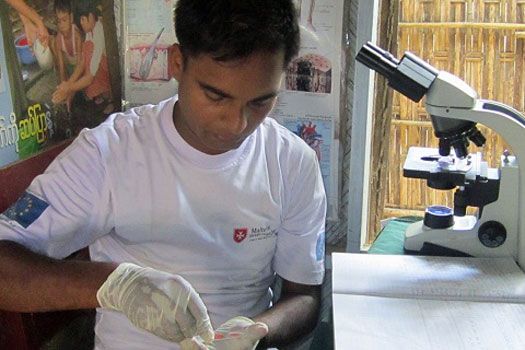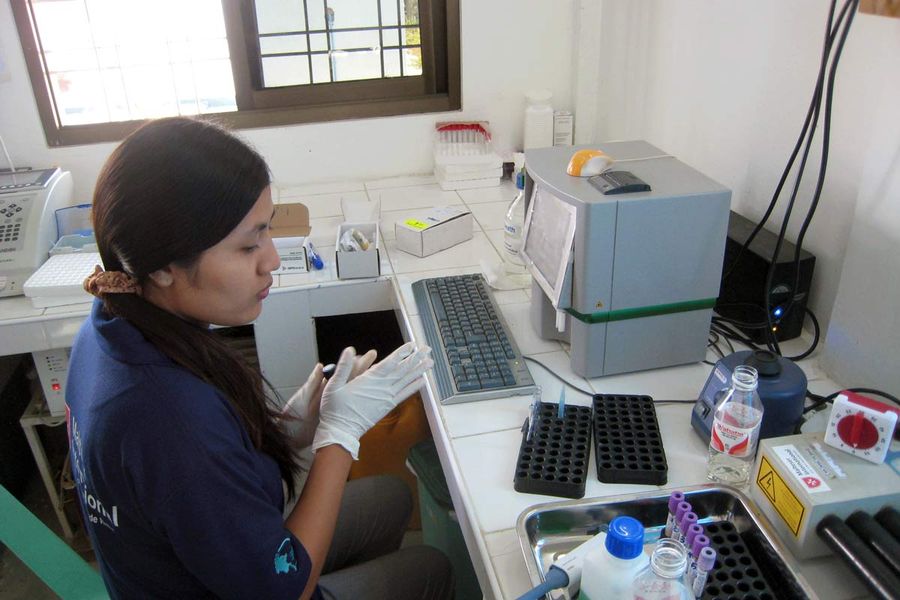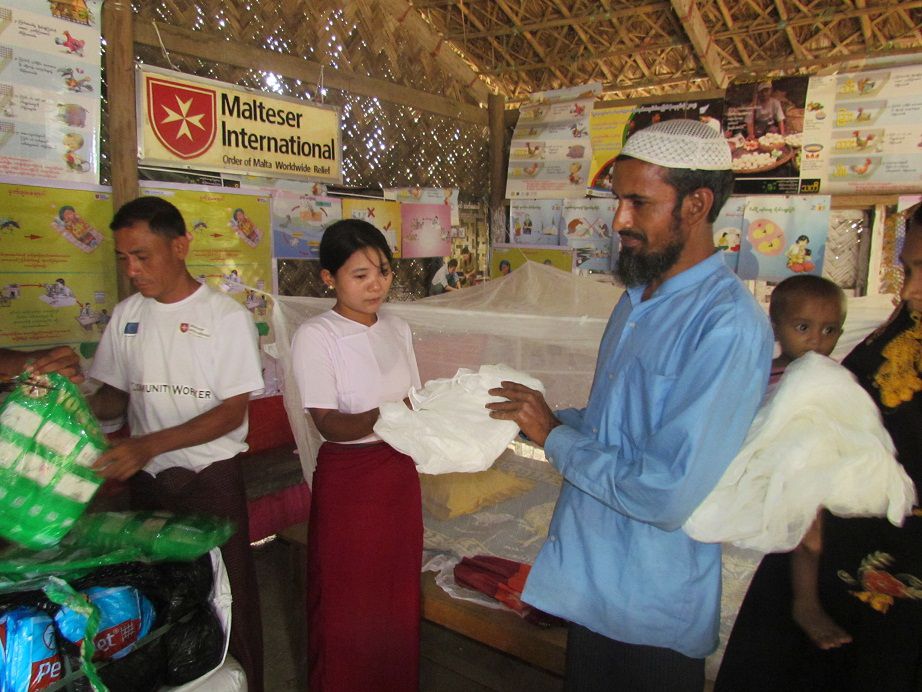Our project to fight malaria
For years, we have been working in Myanmar to ensure that the population has access to malaria diagnosis, treatment and care.
Read more
Malaria occurs mainly in the tropics and subtropics and is one of the most dangerous infectious diseases. Worldwide, more than 100 countries on all continents (except Australia) are affected by the disease. In 2023, according to the World Health Organization (WHO), there were approximately 263 million new cases of malaria worldwide, 95% of which were in Africa. 597,000 of these cases were fatal. Around three quarters of deaths were among children under the age of 5. Malteser International has been working to raise awareness, provide medical care and train health workers in malaria-endemic areas through information campaigns and relief programmes since 2003.

Malaria is an infectious disease that is mainly spread in the tropics and subtropics. It is caused by single-celled parasites, also known as plasmodia, which first multiply in the liver and then pass into the red blood cells, causing them to burst. In this way, more plasmodia enter the bloodstream, which the body tries to fight with fever.
Malaria can be divided into different types based on different pathogens. Malaria tropica as well as malaria tertiana and quartana are the most widespread type of the infectious disease. Malaria tropica is considered the most dangerous type of malaria. Infected red blood cells clog blood vessels and thus cause circulatory disorders. These circulatory disturbances then lead to an undersupply of nutrients to organs, which in turn can lead to coma or, in about 10% of cases, even death. Malaria tertiana and quartana, on the other hand, are rarely fatal.
Malaria is endemic in several countries in Africa and Asia. This means that the tropical disease occurs in waves and can break out at any time, making it a constant threat to the population. Along with Ebola and other serious infectious diseases, malaria is one of the remaining epidemics of the modern era.
A bite that can be fatal: Malaria is transmitted by the female Anopheles mosquito. The mosquito is the host for the small single-celled parasites that cause malaria. Through the bite of the mosquito, the parasites enter the bloodstream of the person and multiply there. The parasites called plasmodia are the actual pathogens of the tropical disease. Malaria is difficult to transmit from person to person. That is why infected people pose no danger to other people. Infection can only occur through blood transfusions with contaminated needles or from the mother to the unborn child.
Malaria does not break out immediately after infection. The incubation period, i.e. the time between infection and the appearance of the first symptoms, depends mainly on the type of pathogen:

At the beginning, malaria often resembles a flu-like infection. Fever attacks, a general feeling of illness, headache and body aches, but also diarrhoea, vomiting and dizziness up to cramps and fainting are common symptoms. In malaria tertiana and quartana, periodic fever attacks are typical - in malaria tertiana every second day, in malaria quartana every third day. The body temperature rises to 40 degrees and is often accompanied by chills. The fever subsides again after three to four hours.
Especially in the case of malaria tropica, the symptoms are more severe and represent an enormous health risk for those affected. The destruction of red blood cells can lead to anaemia and organ damage as well as to an enlarged liver and speen.
In rare cases, the pathogens enter the central nervous system and can trigger seizures, impaired consciousness and coma. In a fatal course of the disease, organ failure of kidney, brain or lung is often the cause of death.
In economically weak countries, those affected are often already weakened by hunger and malnutrition, which is why malaria can cause much more devastating damage to the body.
Malaria is diagnosed by detecting plasmodia in the blood. When malaria is suspected due to symptoms, a blood analysis is carried out first. The blood sample is usually not examined directly on site, but in special tropical institutes. Malaria pathogens can be stained in blood and are easily visible under a microscope. Once it has been determined which pathogen is the cause of the disease, an appropriate therapy is usually started immediately.
Basically, all types of malaria can be cured, provided they are diagnosed early enough. Depending on the type of malaria and the area of infection, various medications are available, including mainly anti-parasitic agents. Symptoms such as fever or pain are additionally treated with ibuprofen or paracetamol. In severe cases where the organs have already been attacked, intensive medical care is needed. In the case of malaria tropica, however, the mortality rate is still 2 % despite early diagnosis and treatment.

In general, mosquito nets, insect repellent and light-coloured clothing are a good protection against malaria. They can prevent a bite from the Anopheles mosquito.
Medication can also protect against malaria. It prevents malaria pathogens from multiplying in the blood and thus protect against an outbreak of the disease. However, this protection is not one hundred percent certain, as in some regions the parasites are already resistant to the medication. Besides, the medicine might not work because of irregular intake or complications because of gastrointestinal infections that prevent the active substances from remaining in the body
In 2021, the WHO recommended the widespread use of a vaccine against malaria for the first time. This is to be seen as a breakthrough in the fight against the disease, especially because of the high child mortality rate from malaria infections. According to the WHO, in pilot trials with children in Africa, a 30% reduction in fatal cases was recorded as a result of the vaccination. The vaccine is effective against the most widespread and dangerous pathogen of malaria tropica in Africa and is expected to save the lives of tens of thousands of children.
There is a particular risk of contracting malaria in sub-Saharan Africa. The countries with most infections are Nigeria, the Democratic Republic of the Congo, Ethiopia and Tanzania. Other areas of circulation are the rainforest regions of South America and in Asia, especially Myanmar, India, Indonesia and Papua New Guinea. Reasons for the high prevalence of the disease in these countries are the tropical climate, limited knowledge about the disease and insufficient hygienic conditions as well as poor living conditions. In the World Malaria Report 2021, the WHO states that 65% of households in sub-Saharan Africa had at least one mosquito net by 2020, increasing from about 5% in 2000. Despite this increase, these data show that millions of people in Africa do not own a proper mosquito net, even though they are an effective form of protection.
According to the World Health Organisation, the fight against malaria is more complicated since the outbreak of COVID-19, with access to mosquito nets, insecticides and medical supplies severely compromised. In addition, Angola experienced a simultaneous outbreak of malaria and dengue fever in 2021, with up to 2,000 cases per day.
The spread of malaria-transmitting mosquitoes in Africa has been detected not only in polluted waters such as lakes and puddles, but also in clean drinking water. This adaptable mosquito species, known as Anopheles stephensi, favours the spread of malaria in urban areas of Africa and poses an increased risk for a rise of the disease.

Malteser International has been active in malaria risk areas for many years. We have been fighting malaria and tuberculosis in Myanmar since 2003 for example. The aim of our aid projects is to educate people and to treat those who are ill. In addition, we train health trainers who pass on their knowledge to the population and contribute to a collective understanding of the disease, routes of infection and prevention measures. Safely managed water, sanitation, and hygiene (WASH) services are essential to improve hygienic conditions and thus prevent infectious disease outbreaks.
There is particular emphasis on appropriate diagnostic possibilities so that infectious diseases can be recognised more quickly and subsequently treated. To draw attention to the need for aid measures in the fight against malaria, the WHO has established World Malaria Day on 25 April and publishes the World Malaria Report every year.
With your donation, you can support our fight against malaria. We inform the population about malaria, teach them how to avoid infection and provide mosquito nets. Your donations also help us to ensure that people at risk of malaria have access to health care, and that if they do fall ill, they receive timely diagnosis and treatment at the health facilities we support. With these simple tools, they can effectively protect themselves against malaria.
For years, we have been working in Myanmar to ensure that the population has access to malaria diagnosis, treatment and care.
Read more